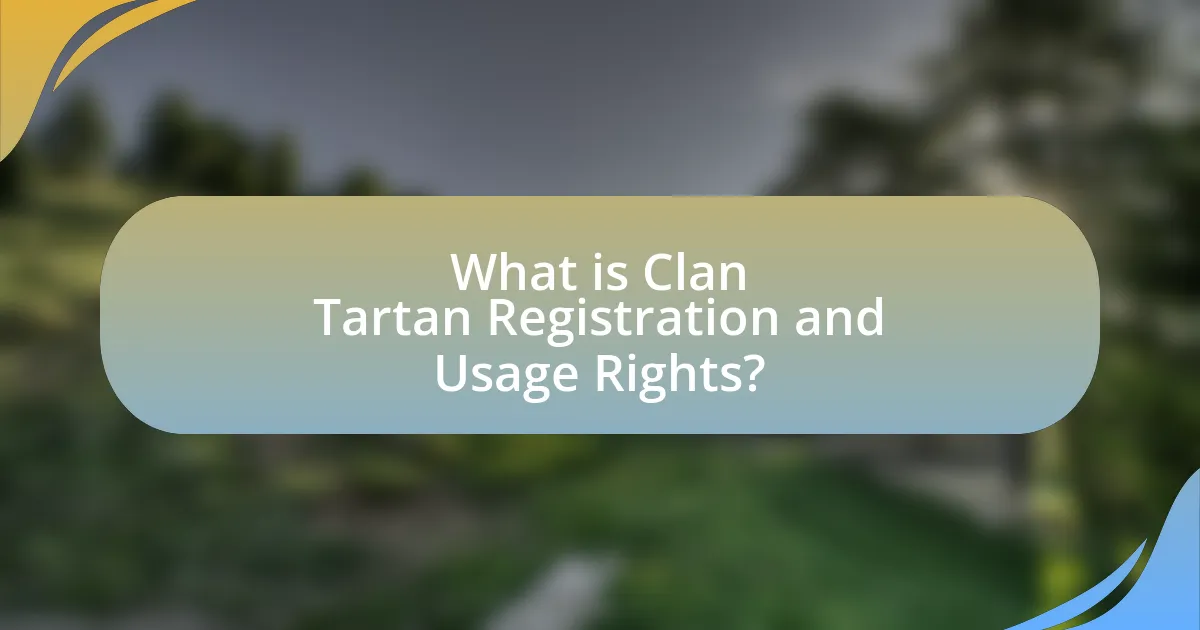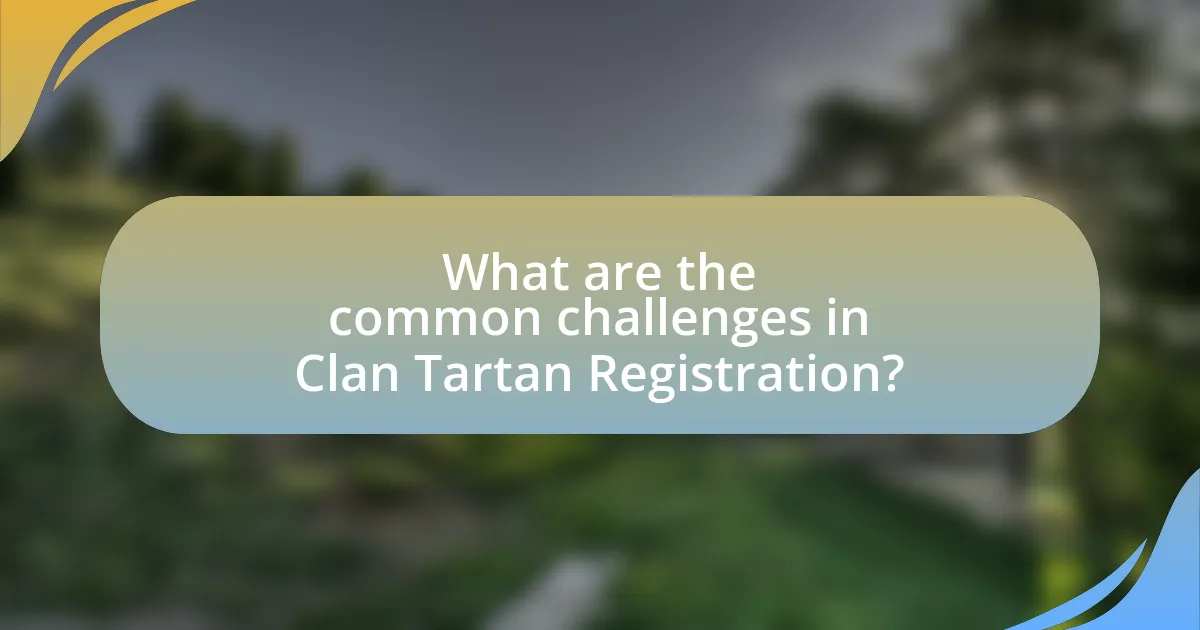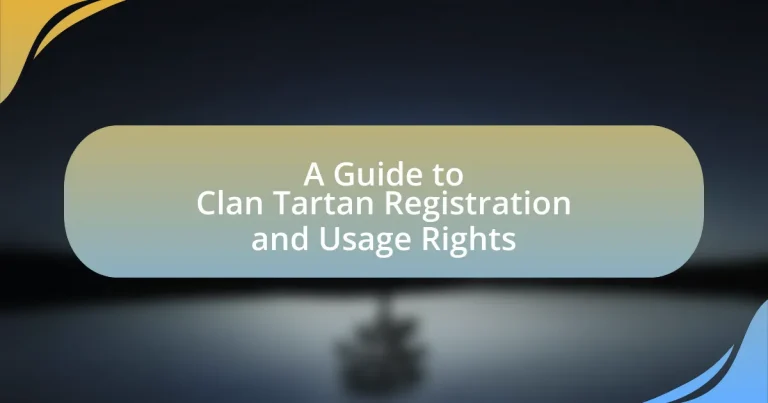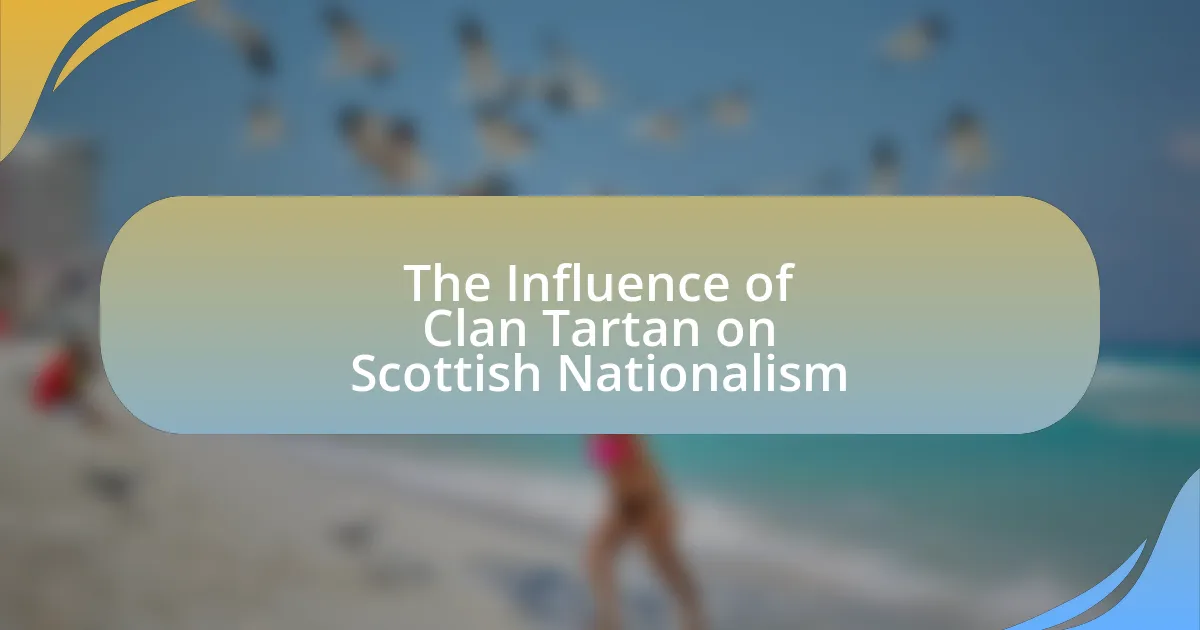Clan Tartan Registration is the official process of recording tartan patterns linked to specific clans or families, ensuring their recognition and protection against unauthorized use. Managed by organizations such as the Scottish Register of Tartans, this registration preserves cultural heritage and grants usage rights primarily to clan members. The article outlines the importance of tartan registration, its historical significance, the criteria and process for registration, and the legal implications of misuse. Additionally, it addresses common challenges clans face during registration, strategies for promoting registered tartans, and resources available for clans to navigate usage rights effectively.

What is Clan Tartan Registration and Usage Rights?
Clan Tartan Registration refers to the official process of recording a specific tartan pattern associated with a clan or family, ensuring its recognition and protection. This registration is typically managed by organizations such as the Scottish Register of Tartans, which maintains a database of registered tartans to prevent unauthorized use. Usage rights pertain to the permissions granted to individuals or groups to use the registered tartan, often limited to members of the clan or family associated with that tartan. The registration process helps preserve cultural heritage and provides legal backing against misuse, ensuring that the tartan remains a symbol of identity for the clan.
Why is Clan Tartan Registration important?
Clan Tartan Registration is important because it provides legal recognition and protection for specific tartan patterns associated with clans. This registration helps to preserve cultural heritage by ensuring that the designs are not misused or appropriated by unauthorized parties. Additionally, registered tartans can be used to foster a sense of identity and belonging among clan members, as they serve as a symbol of lineage and tradition. The Scottish Register of Tartans, established in 2008, maintains a comprehensive database that validates these patterns, ensuring that they are officially recognized and can be used in various contexts, from clothing to ceremonial events.
What historical significance does tartan hold for clans?
Tartan holds historical significance for clans as it serves as a symbol of identity, heritage, and unity among clan members. Each tartan pattern is often associated with a specific clan, reflecting its lineage and history. For example, the Campbell tartan is recognized as representing the Clan Campbell, while the MacDonald tartan signifies the Clan MacDonald. Historically, these patterns were used to distinguish clans during conflicts and gatherings, fostering a sense of belonging and loyalty. The use of tartan has been documented since the 16th century, with the Scottish Act of 1746 prohibiting the wearing of tartan as a means to suppress Highland culture, further solidifying its role as a symbol of resistance and cultural pride.
How does registration protect clan identity?
Registration protects clan identity by formally recognizing and documenting the unique symbols, tartans, and heritage associated with a specific clan. This official acknowledgment helps prevent unauthorized use or misrepresentation of the clan’s identity, ensuring that only members or authorized individuals can use the clan’s tartan and associated symbols. For instance, organizations like the Scottish Register of Tartans maintain a database that safeguards these identities, providing legal recourse against misuse and fostering a sense of belonging among clan members.
What are the key components of Clan Tartan Registration?
The key components of Clan Tartan Registration include the submission of a unique tartan design, the identification of the clan or family associated with the tartan, and the approval process by a recognized authority, such as the Scottish Register of Tartans. The unique design must adhere to specific color and pattern guidelines to ensure it is distinct from existing tartans. Additionally, the registration process requires documentation that verifies the clan’s heritage and the intended use of the tartan, which helps maintain the integrity and cultural significance of the tartan within Scottish heritage.
What criteria must be met for tartan registration?
To register a tartan, the criteria that must be met include the submission of a unique design that is not already registered, along with a clear description of the tartan’s colors and patterns. Additionally, the applicant must provide evidence of the tartan’s association with a specific clan, family, or organization, which can be demonstrated through historical or cultural connections. The registration process is overseen by the Scottish Register of Tartans, which ensures that all submissions adhere to these guidelines to maintain the integrity of tartan heritage.
How is a tartan pattern defined and documented?
A tartan pattern is defined as a specific arrangement of colored stripes that intersect at right angles, creating a distinctive design. Tartan patterns are documented through a standardized system that includes a detailed description of the colors, the thread count, and the arrangement of the stripes, often recorded in a register maintained by organizations such as the Scottish Register of Tartans. This documentation ensures that each tartan is unique and can be traced back to its origins, often linked to specific clans or regions in Scotland, thereby preserving cultural heritage and usage rights.
What rights do clans have regarding their registered tartans?
Clans have the exclusive right to control the use of their registered tartans, which includes the authority to license their tartans for commercial use. This right is established through the registration process, where clans can officially register their tartans with organizations such as the Scottish Register of Tartans. The registration provides legal recognition and protection, allowing clans to prevent unauthorized use and to ensure that their tartans are used in a manner that aligns with their heritage and identity.
How can clans enforce their usage rights?
Clans can enforce their usage rights by establishing legal frameworks and agreements that define ownership and control over their tartan designs. These frameworks often include registering the tartan with official bodies, such as the Scottish Register of Tartans, which provides legal recognition and protection against unauthorized use. Additionally, clans may pursue legal action against individuals or organizations that infringe upon their rights, utilizing trademark laws to safeguard their unique tartan patterns. This approach is supported by the fact that registered tartans are protected under intellectual property laws, which can deter misuse and ensure that clans maintain their cultural heritage and identity.
What are the legal implications of tartan misuse?
The legal implications of tartan misuse primarily involve potential trademark infringement and violation of intellectual property rights. When a tartan pattern is registered as a trademark, unauthorized use can lead to legal action from the rights holder, including cease and desist orders or lawsuits for damages. For instance, the Scottish Register of Tartans allows clans to register their unique patterns, granting them exclusive rights to their use. Misusing a registered tartan without permission can result in penalties, as established by trademark law, which protects the identity and heritage associated with specific tartans.

How does the Clan Tartan Registration process work?
The Clan Tartan Registration process involves submitting a design to the Scottish Register of Tartans, where it is reviewed for uniqueness and adherence to specific guidelines. The process begins with the applicant completing a registration form that includes details about the tartan’s design, colors, and intended use. Once submitted, the application is assessed by the Registrar, who checks for any existing similar designs and ensures compliance with the registration criteria. If approved, the tartan is officially recorded, granting the applicant usage rights and recognition of their design. This process is governed by the Scottish Government’s regulations, ensuring that all registered tartans are distinct and properly documented.
What steps are involved in registering a tartan?
To register a tartan, one must follow a series of specific steps. First, the individual or organization must create a unique tartan design, ensuring it is distinct from existing patterns. Next, they should gather necessary documentation, including a description of the tartan’s colors and patterns, as well as its intended use. After preparing the design and documentation, the applicant submits these materials to the Scottish Register of Tartans, which is managed by the National Records of Scotland. The submission is then reviewed for compliance with registration criteria. If approved, the tartan is officially registered and assigned a unique reference number, making it part of the official tartan registry. This process ensures that the tartan is recognized and protected under Scottish heritage laws.
What documentation is required for registration?
To register a clan tartan, the required documentation typically includes a completed registration form, a detailed description of the tartan design, and proof of the clan’s heritage or association. The registration form must be accurately filled out to ensure proper processing, while the description should include the colors and patterns used in the tartan. Proof of heritage can be established through historical records, clan charters, or genealogical documentation that links the applicant to the clan. These requirements ensure that the registration process is legitimate and preserves the cultural significance of the tartan.
How long does the registration process typically take?
The registration process typically takes between four to six weeks. This timeframe is based on the standard procedures followed by registration authorities, which include reviewing applications, verifying information, and processing the necessary documentation. Factors such as the completeness of the application and the volume of submissions can influence the duration, but the average remains consistent within this range.
Who oversees the Clan Tartan Registration process?
The Clan Tartan Registration process is overseen by the Scottish Register of Tartans. This official body was established to maintain a comprehensive record of tartans and ensure their proper registration. The Scottish Register of Tartans operates under the auspices of the Scottish Government, which provides the legal framework for the registration process, ensuring that all tartans are documented accurately and can be used appropriately by clans and individuals.
What organizations are responsible for tartan registration?
The organizations responsible for tartan registration are the Scottish Register of Tartans and the Tartan Authority. The Scottish Register of Tartans, established by the Scottish Parliament in 2008, serves as the official repository for tartan designs in Scotland. The Tartan Authority, a non-profit organization, provides guidance on tartan usage and promotes the cultural significance of tartans. Both organizations ensure that tartans are properly documented and recognized, maintaining the integrity of tartan heritage.
How do these organizations maintain tartan records?
Organizations maintain tartan records through systematic documentation and registration processes. They typically require detailed submissions that include the tartan’s design specifications, colors, and associated clan or family history. For instance, the Scottish Register of Tartans, established by the Scottish Government, ensures that each registered tartan is cataloged with unique identifiers and descriptions, allowing for accurate tracking and preservation of tartan heritage. This structured approach not only safeguards the integrity of tartan designs but also provides a reliable reference for usage rights and cultural significance.

What are the common challenges in Clan Tartan Registration?
Common challenges in Clan Tartan Registration include the complexity of proving lineage, the potential for disputes over tartan designs, and the lack of standardized registration processes. Proving lineage is essential as many clans require documented evidence of descent to establish eligibility for registration. Disputes can arise when multiple individuals or groups claim rights to the same tartan design, leading to conflicts that can complicate the registration process. Additionally, the absence of a unified system for tartan registration across different organizations can create confusion and inconsistency, making it difficult for clans to navigate the registration landscape effectively.
What issues do clans face during the registration process?
Clans face several issues during the registration process, primarily including bureaucratic complexities, lack of clear guidelines, and potential disputes over tartan designs. Bureaucratic complexities arise from navigating the various requirements set by registration bodies, which can be confusing and time-consuming. The lack of clear guidelines often leads to misunderstandings about what is needed for successful registration, resulting in incomplete applications. Additionally, disputes over tartan designs can occur when multiple clans claim rights to similar patterns, complicating the registration process further. These challenges can hinder clans from achieving official recognition and usage rights for their tartans.
How can clans resolve disputes over tartan designs?
Clans can resolve disputes over tartan designs through formal registration processes and mediation. The Scottish Register of Tartans provides a legal framework for clans to register their unique tartan patterns, which helps establish ownership and usage rights. When disputes arise, clans can engage in mediation facilitated by organizations such as the Scottish Tartans Authority, which offers guidance and support in resolving conflicts amicably. This approach is supported by the historical context of tartan usage, where clans have traditionally sought to protect their identities and heritage through established protocols.
What are the consequences of failing to register a tartan?
Failing to register a tartan can result in the loss of exclusive rights to its use, leading to potential unauthorized reproduction by others. Without registration, the tartan lacks formal recognition, making it difficult to assert ownership or protect against infringement. This can diminish the tartan’s cultural significance and value, as unregistered designs may be freely used by anyone, undermining the identity and heritage associated with the clan. Additionally, unregistered tartans may not be eligible for inclusion in official records, such as the Scottish Register of Tartans, which serves as a definitive source for tartan designs and their associated clans.
How can clans effectively promote their registered tartans?
Clans can effectively promote their registered tartans by leveraging social media platforms, organizing community events, and collaborating with retailers. Social media allows clans to reach a broad audience, showcasing their tartans through engaging content and storytelling. Community events, such as Highland games or clan gatherings, provide opportunities for members to wear and display their tartans, fostering a sense of pride and visibility. Collaborating with retailers ensures that the tartans are available for purchase, increasing accessibility and awareness. These strategies are supported by the growing trend of heritage tourism, where individuals seek authentic cultural experiences, thus enhancing the appeal of registered tartans.
What marketing strategies can be used for tartan promotion?
Effective marketing strategies for tartan promotion include leveraging social media campaigns, collaborating with influencers, and participating in cultural events. Social media platforms like Instagram and Facebook allow for visually appealing content showcasing tartan designs, which can attract a wider audience. Collaborating with influencers who resonate with heritage and fashion can enhance visibility and credibility. Additionally, participating in cultural events, such as Highland games or Scottish festivals, provides direct engagement with target audiences, fostering community connections and increasing brand awareness. These strategies are supported by the growing interest in heritage fashion, as evidenced by a 2021 report from the Fashion Institute of Technology, which highlighted a 30% increase in consumer interest in traditional textiles.
How can clans engage with their community regarding tartan usage?
Clans can engage with their community regarding tartan usage by organizing events that promote awareness and education about tartan heritage. These events can include workshops, exhibitions, and community gatherings where clan members share the history and significance of their specific tartans. For instance, the Scottish Tartans Authority provides resources and guidelines that clans can utilize to educate their members and the public about tartan registration and usage rights. By actively participating in local festivals or cultural events, clans can showcase their tartans, fostering a sense of community and pride while encouraging discussions about their historical and cultural importance.
What best practices should clans follow for tartan usage rights?
Clans should ensure they have formal registration of their tartan with the Scottish Register of Tartans to establish usage rights. This registration provides legal recognition and protects the tartan from unauthorized use. Additionally, clans should create clear guidelines for the use of their tartan, specifying who can use it and under what circumstances, which helps maintain the integrity and heritage associated with the tartan. Furthermore, clans should educate their members about the significance of the tartan and the importance of adhering to these guidelines, fostering a sense of responsibility and respect for their cultural symbols.
How can clans educate members about tartan rights?
Clans can educate members about tartan rights through organized workshops, informational resources, and community engagement initiatives. Workshops can provide detailed explanations of tartan registration processes, historical significance, and legal rights associated with tartans. Informational resources, such as pamphlets or online guides, can outline the rules and regulations governing tartan usage, including the importance of proper registration with organizations like the Scottish Register of Tartans. Community engagement initiatives, such as clan gatherings or events, can foster discussions and share experiences related to tartan rights, ensuring that members are well-informed and connected to their heritage.
What resources are available for clans to navigate tartan usage?
Clans can utilize several resources to navigate tartan usage, including the Scottish Register of Tartans, which provides official registration and guidelines for tartan designs. This register, maintained by the National Records of Scotland, ensures that clans can protect their tartan patterns and understand their usage rights. Additionally, organizations such as the Scottish Tartans Authority offer educational materials and support for clans regarding tartan history and proper usage. These resources are essential for clans to maintain their heritage and ensure compliance with tartan regulations.





